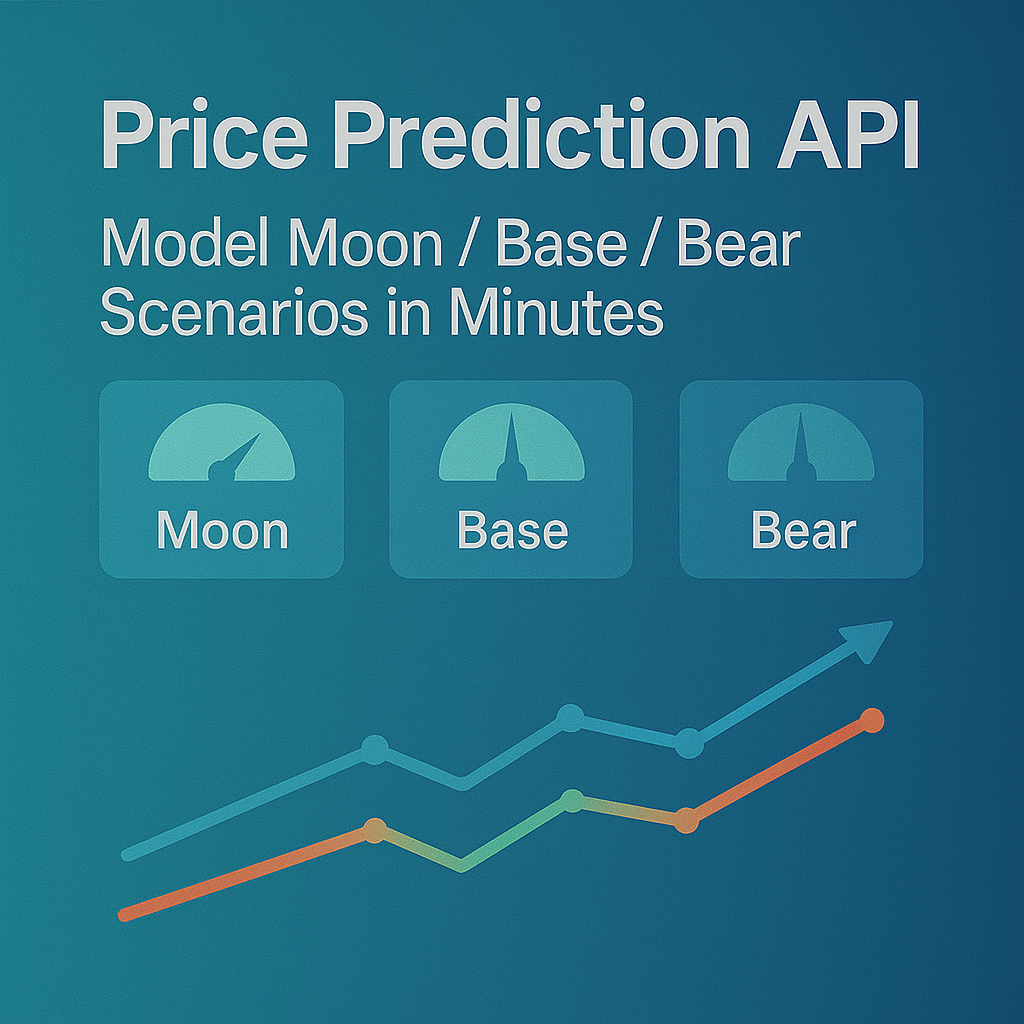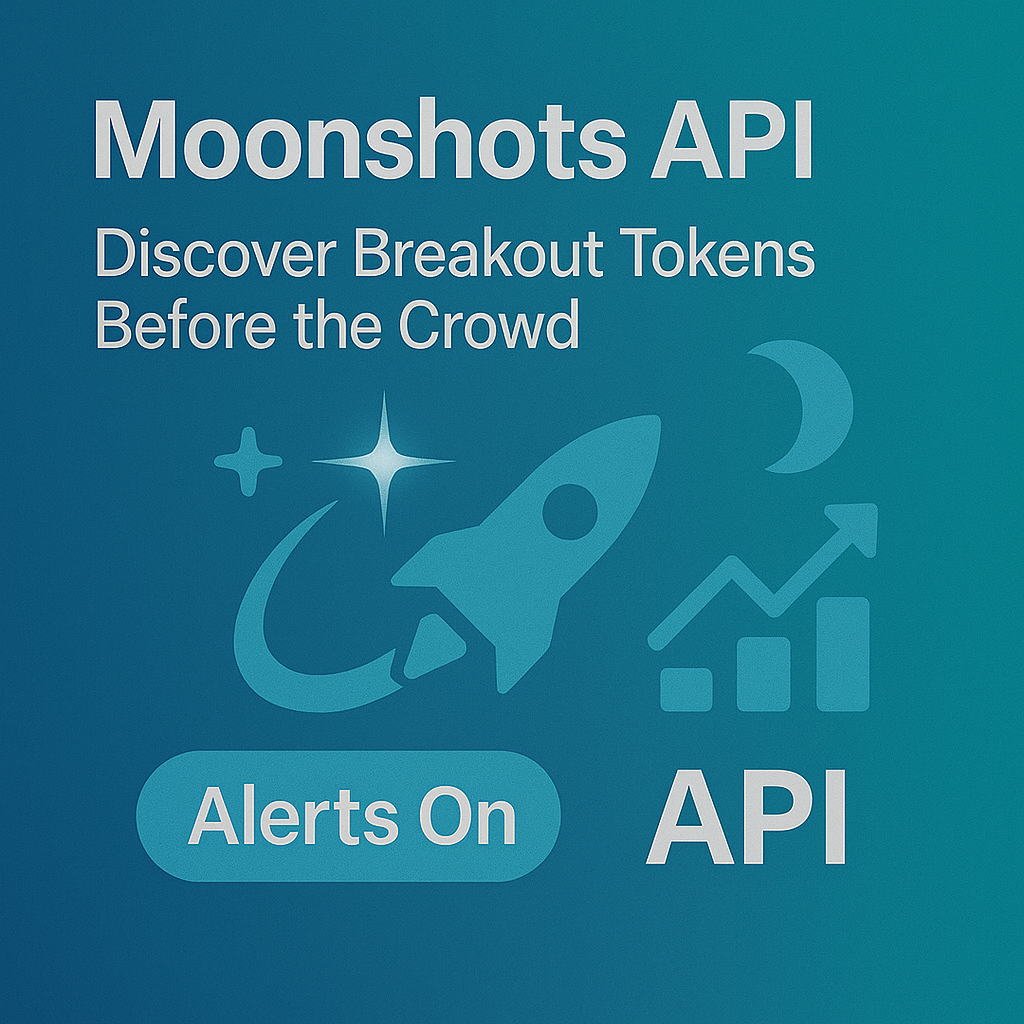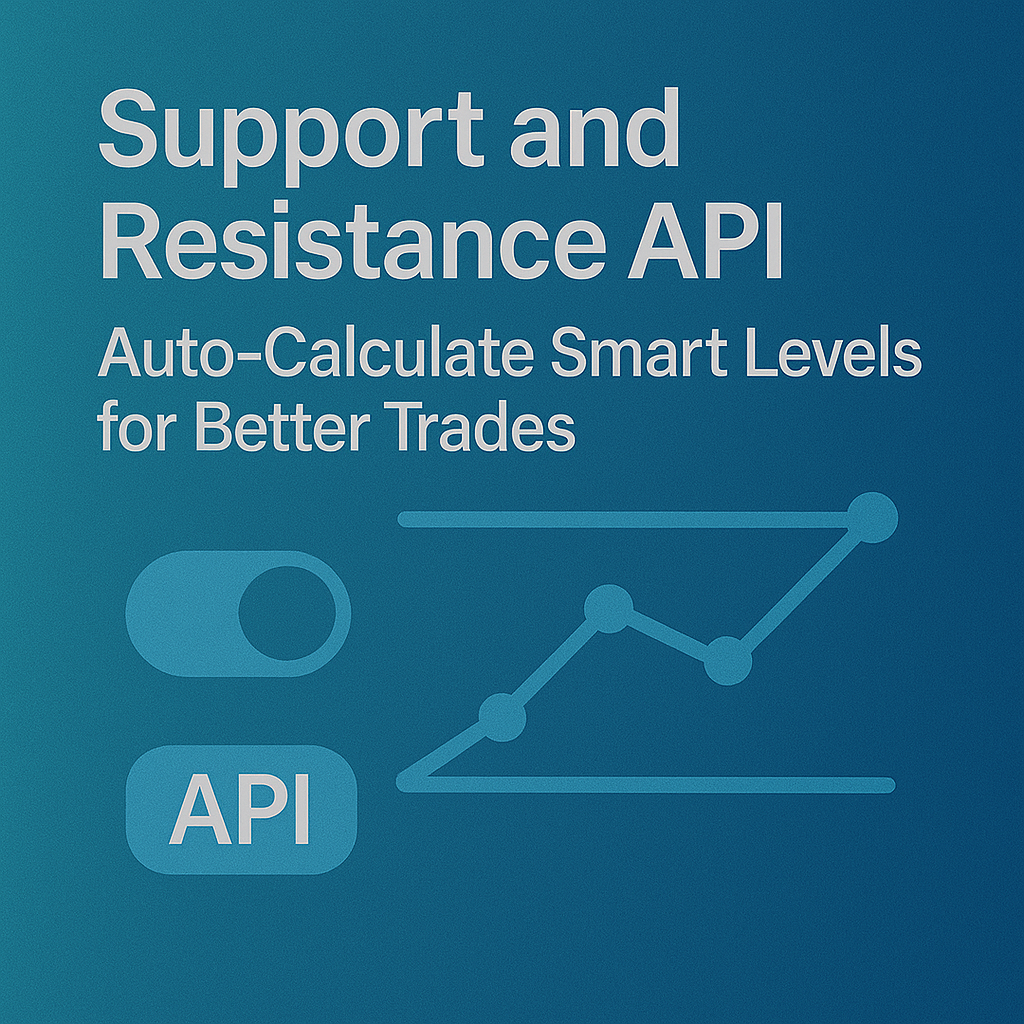Top Crypto Trading Platforms in 2025







%201.svg)
%201.svg)
Big news: We’re cranking up the heat on AI-driven crypto analytics with the launch of the Token Metrics API and our official SDK (Software Development Kit). This isn’t just an upgrade – it's a quantum leap, giving traders, hedge funds, developers, and institutions direct access to cutting-edge market intelligence, trading signals, and predictive analytics.
Crypto markets move fast, and having real-time, AI-powered insights can be the difference between catching the next big trend or getting left behind. Until now, traders and quants have been wrestling with scattered data, delayed reporting, and a lack of truly predictive analytics. Not anymore.
The Token Metrics API delivers 32+ high-performance endpoints packed with powerful AI-driven insights right into your lap, including:
Getting started with the Token Metrics API is simple:
At Token Metrics, we believe data should be decentralized, predictive, and actionable.
The Token Metrics API & SDK bring next-gen AI-powered crypto intelligence to anyone looking to trade smarter, build better, and stay ahead of the curve. With our official SDK, developers can plug these insights into their own trading bots, dashboards, and research tools – no need to reinvent the wheel.
%201.svg)
%201.svg)
The biggest gains in crypto rarely come from the majors. They come from Moonshots—fast-moving tokens with breakout potential. The Moonshots API surfaces these candidates programmatically so you can rank, alert, and act inside your product. In this guide, you’ll call /v2/moonshots, display a high-signal list with TM Grade and Bullish tags, and wire it into bots, dashboards, or screeners in minutes. Start by grabbing your key at Get API Key, then Run Hello-TM and Clone a Template to ship fast.
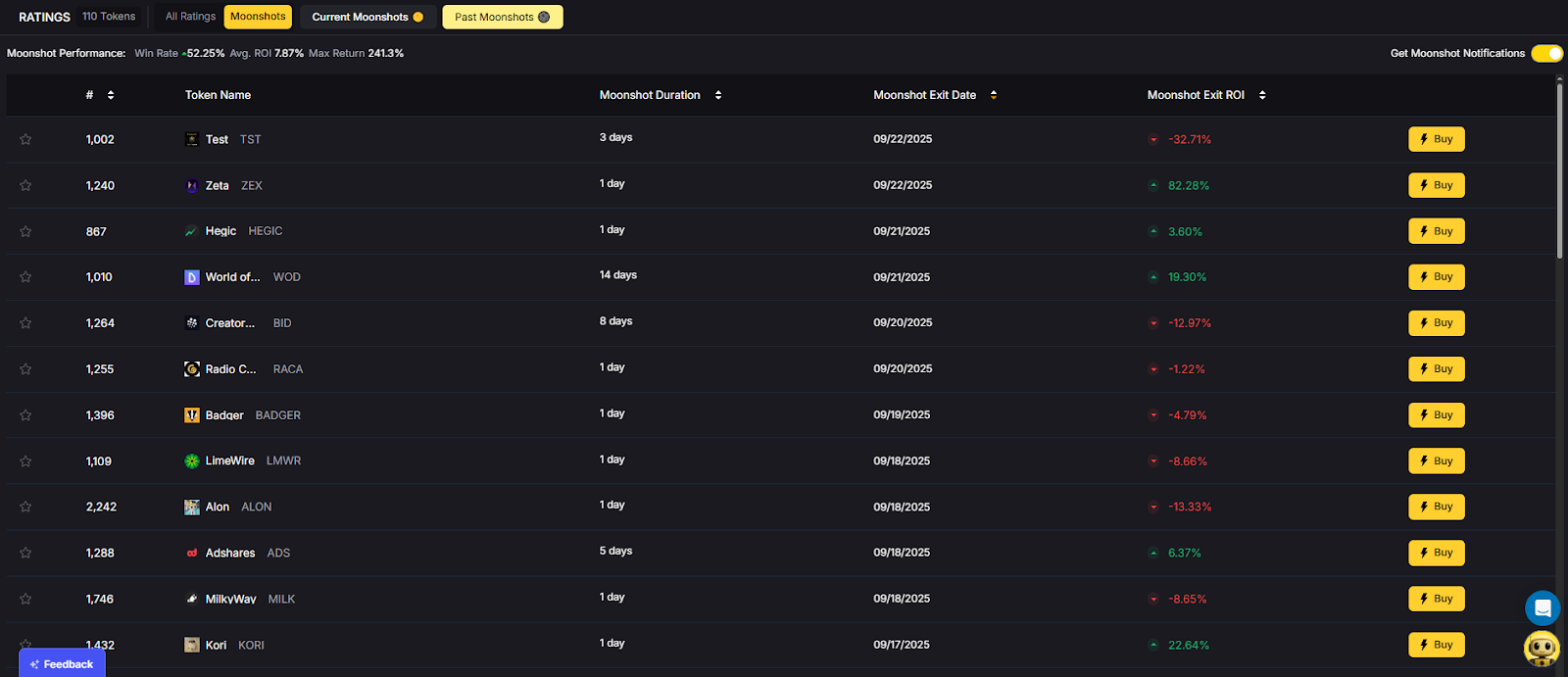
Discovery that converts. Users want more than price tickers—they want a curated, explainable list of high-potential tokens. The moonshots API encapsulates multiple signals into a short list designed for exploration, alerts, and watchlists you can monetize.
Built for builders. The endpoint returns a consistent schema with grade, signal, and context so you can immediately sort, badge, and trigger workflows. With predictable latency and clear filters, you can scale to dashboards, mobile apps, and headless bots without reinventing the discovery pipeline.
The Moonshots API cURL request is right there in the top right of the API Reference. Grab it and start tapping into the potential!
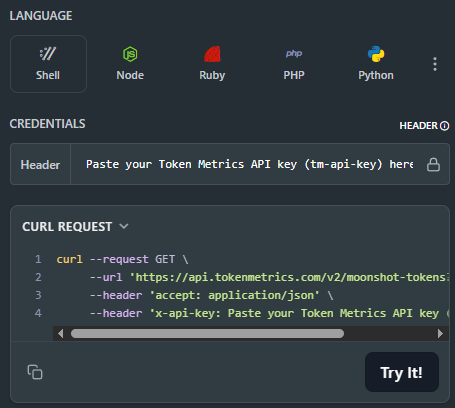
👉 Keep momentum: Get API Key • Run Hello-TM • Clone a Template
Fork a screener or alerting template, plug your key, and deploy. Validate your environment with Hello-TM. When you scale users or need higher limits, compare API plans.
The Moonshots endpoint aggregates a set of evidence—often combining TM Grade, signal state, and momentum/volume context—into a shortlist of breakout candidates. Each row includes a symbol, grade, signal, and timestamp, plus optional reason tags for transparency.
For UX, a common pattern is: headline list → token detail where you render TM Grade (quality), Trading Signals (timing), Support/Resistance (risk placement), Quantmetrics (risk-adjusted performance), and Price Prediction scenarios. This lets users understand why a token was flagged and how to act with risk controls.
Polling vs webhooks. Dashboards typically poll with short-TTL caching. Alerting flows use scheduled jobs or webhooks (where available) to smooth traffic and avoid duplicates. Always make notifications idempotent.
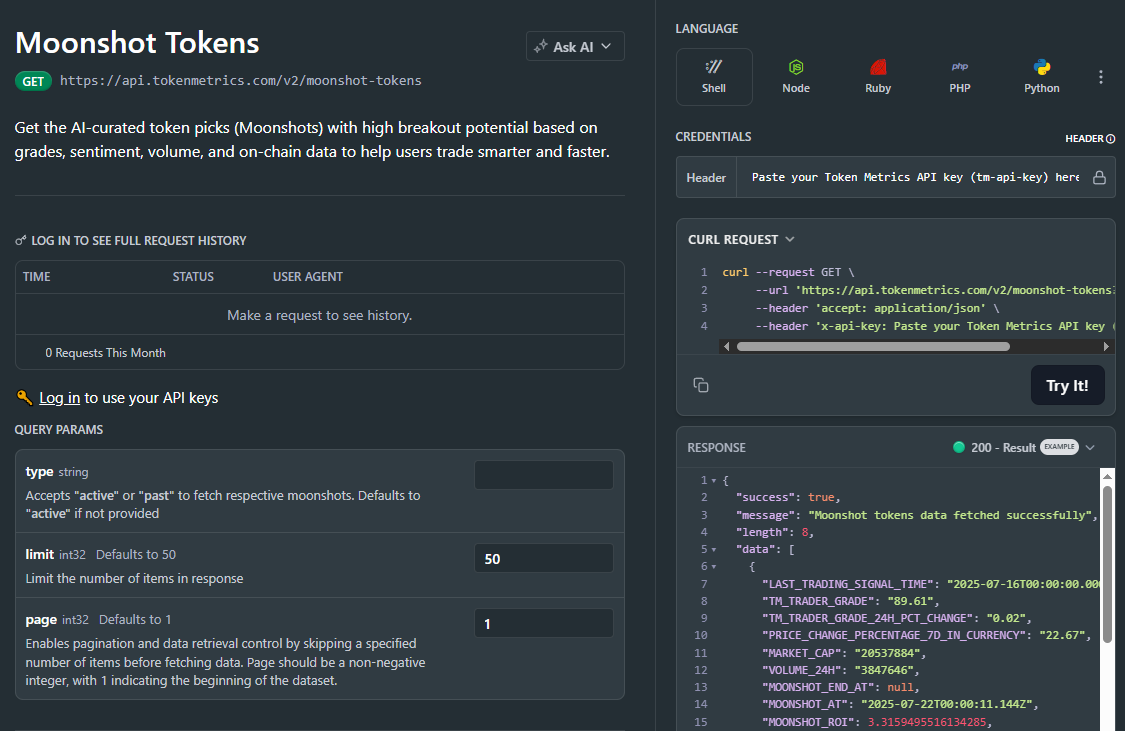
1) What does the Moonshots API return?
A list of breakout candidates with fields such as symbol, tm_grade, signal (often Bullish/Bearish), optional reason tags, and updated_at. Use it to drive discover tabs, alerts, and watchlists.
2) How fresh is the list? What about latency/SLOs?
The endpoint targets predictable latency and timely updates for dashboards and alerts. Use short-TTL caching and queued jobs/webhooks to avoid bursty polling.
3) How do I use Moonshots in a trading workflow?
Common stack: Moonshots for discovery, Trading Signals for timing, Support/Resistance for SL/TP, Quantmetrics for sizing, and Price Prediction for scenario context. Always backtest and paper-trade first.
4) I saw results like “+241%” and a “7.5% average return.” Are these guaranteed?
No. Any historical results are illustrative and not guarantees of future performance. Markets are risky; use risk management and testing.
5) Can I filter the Moonshots list?
Yes—pass parameters like min_grade, signal, and limit (as supported) to tailor to your audience and keep pages fast.
6) Do you provide SDKs or examples?
REST works with JavaScript and Python snippets above. Docs include quickstarts, Postman collections, and templates—start with Run Hello-TM.
7) Pricing, limits, and enterprise SLAs?
Begin free and scale up. See API plans for rate limits and enterprise options.
%201.svg)
%201.svg)
Most traders still draw lines by hand in TradingView. The support and resistance API from Token Metrics auto-calculates clean support and resistance levels from one request, so your dashboard, bot, or alerts can react instantly. In minutes, you’ll call /v2/resistance-support, render actionable levels for any token, and wire them into stops, targets, or notifications. Start by grabbing your key on Get API Key, then Run Hello-TM and Clone a Template to ship a production-ready feature fast.
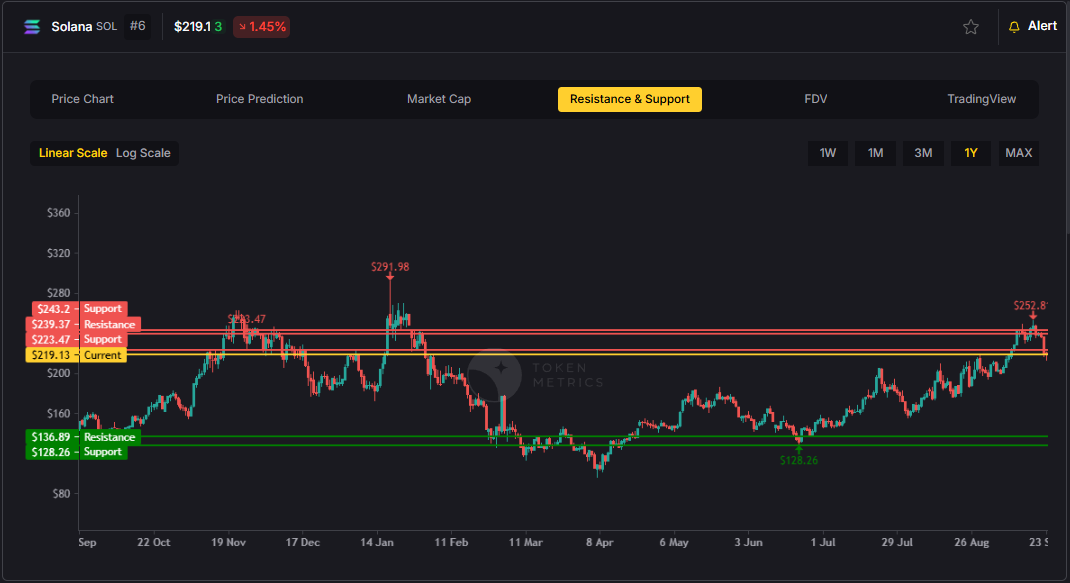
Precision beats guesswork. Hand-drawn lines are subjective and slow. The support and resistance API standardizes levels across assets and timeframes, enabling deterministic stops and take-profits your users (and bots) can trust.
Production-ready by design. A simple REST shape, predictable latency, and clear semantics let you add levels to token pages, automate SL/TP alerts, and build rule-based execution with minimal glue code.
Need the Support and Resistance data? The cURL request for it is in the top right of the API Reference for quick access.
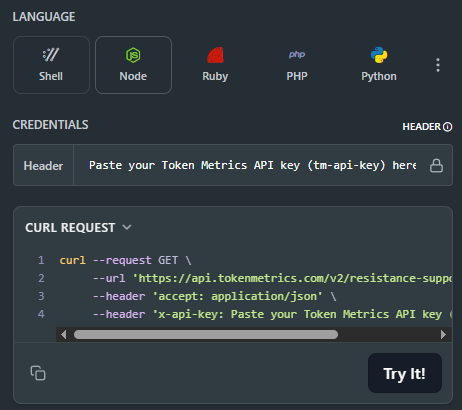
👉 Keep momentum: Get API Key • Run Hello-TM • Clone a Template
Kick off with our quickstarts—fork a bot or dashboard template, plug your key, and deploy. Confirm your environment by Running Hello-TM. When you’re scaling or need webhooks/limits, review API plans.
The Support/Resistance endpoint analyzes recent price structure to produce discrete levels above and below current price, along with strength indicators you can use for priority and styling. Query /v2/resistance-support?symbol=<ASSET>&timeframe=<HORIZON> to receive arrays of level objects and timestamps.
Polling vs webhooks. For dashboards, short-TTL caching and batched fetches keep pages snappy. For bots and alerts, use queued jobs or webhooks (where applicable) to avoid noisy, bursty polling—especially around market opens and major events.
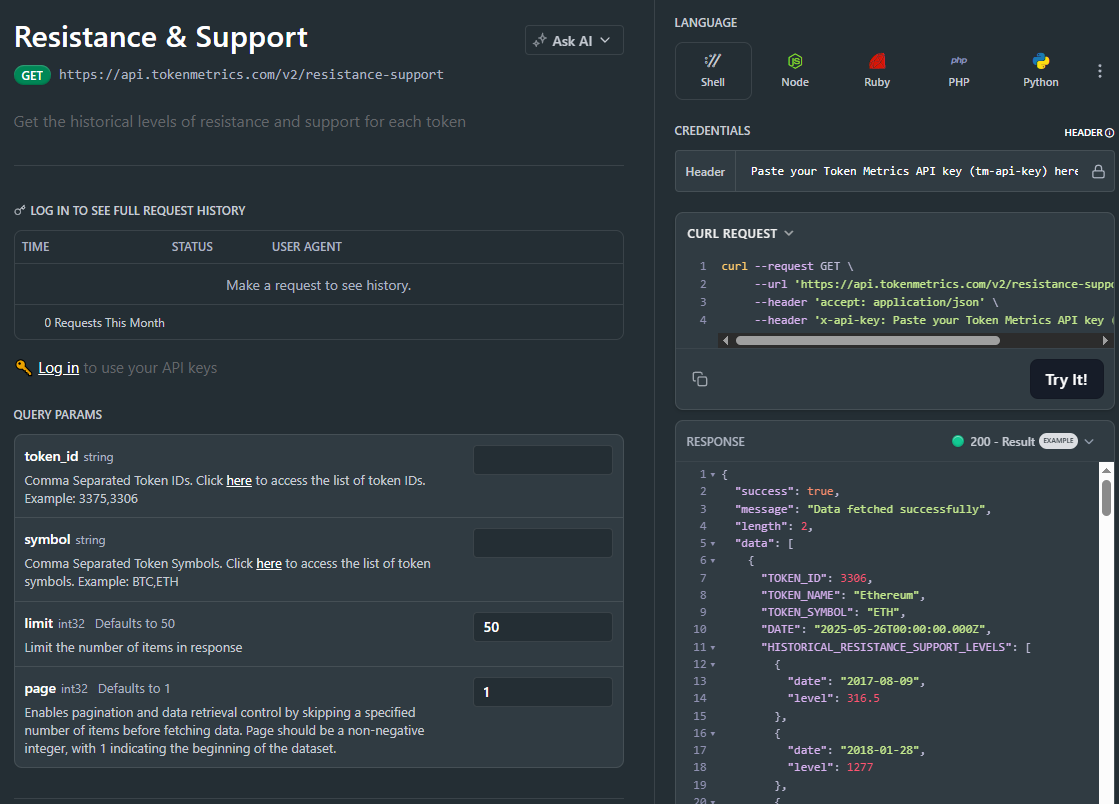
1) What does the Support & Resistance API return?
A JSON payload with arrays of support and resistance levels for a symbol (and optional timeframe), each with a price and strength indicator, plus an update timestamp.
2) How timely are the levels? What are the latency/SLOs?
The endpoint targets predictable latency suitable for dashboards and alerts. Use short-TTL caching for UIs, and queued jobs or webhooks for alerting to smooth traffic.
3) How do I trigger alerts or trades from levels?
Common patterns: alert when price is within X% of a level, touches a level, or breaks beyond with confirmation. Always make downstream actions idempotent and respect rate limits.
4) Can I combine levels with other endpoints?
Yes—pair with /v2/trading-signals for timing, /v2/tm-grade for quality context, and /v2/quantmetrics for risk sizing. This yields a complete decide-plan-execute loop.
5) Which timeframe should I use?
Intraday bots prefer shorter horizons; swing/position dashboards use daily or higher-timeframe levels. Offer a timeframe toggle and cache results per setting.
6) Do you provide SDKs or examples?
Use the REST snippets above (JS/Python). The docs include quickstarts, Postman collections, and templates—start with Run Hello-TM.
7) Pricing, limits, and enterprise SLAs?
Begin free and scale as you grow. See API plans for rate limits and enterprise SLA options.
%201.svg)
%201.svg)
Most traders see price—quants see probabilities. The Quantmetrics API turns raw performance into risk-adjusted stats like Sharpe, Sortino, volatility, drawdown, and CAGR so you can compare tokens objectively and build smarter bots and dashboards. In minutes, you’ll query /v2/quantmetrics, render a clear performance snapshot, and ship a feature that customers trust. Start by grabbing your key at Get API Key, Run Hello-TM to verify your first call, then Clone a Template to go live fast.
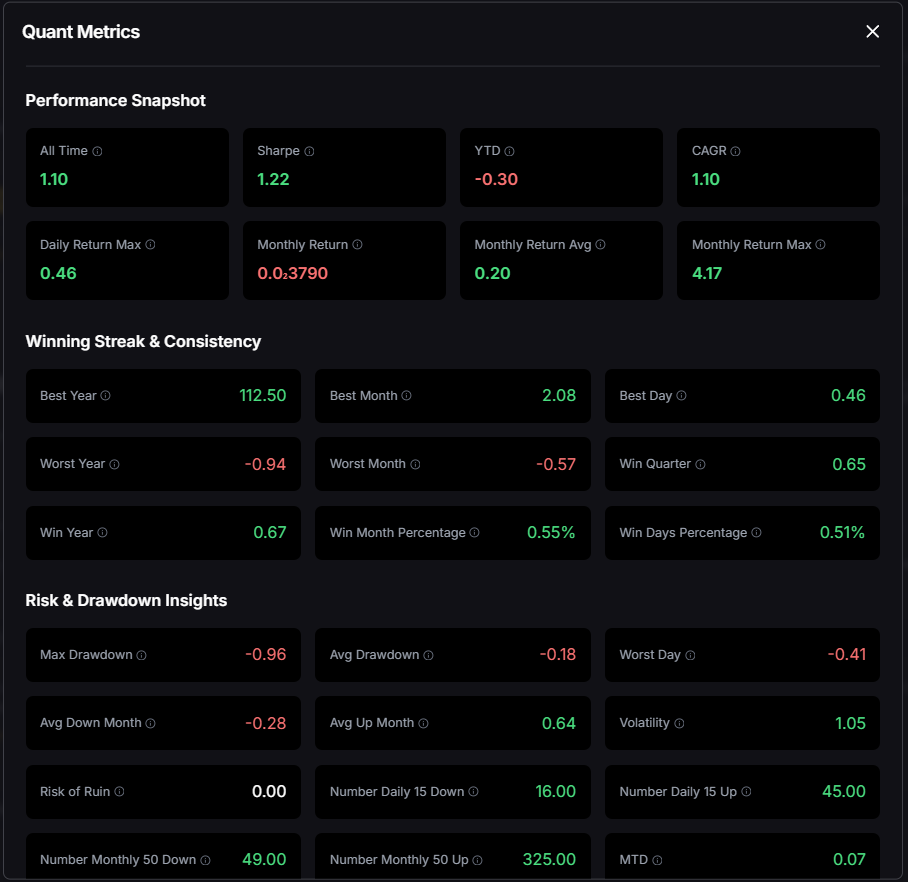
Risk-adjusted truth beats hype. Price alone hides tail risk and whipsaws. Quantmetrics compresses edge, risk, and consistency into metrics that travel across assets and timeframes—so you can rank universes, size positions, and communicate performance like a pro.
Built for dev speed. A clean REST schema, predictable latency, and easy auth mean you can plug Sharpe/Sortino into bots, dashboards, and screeners without maintaining your own analytics pipeline. Pair with caching and batching to serve fast pages at scale.
The Quant Metrics cURL request is located in the top right of the API Reference, allowing you to easily integrate it with your application.
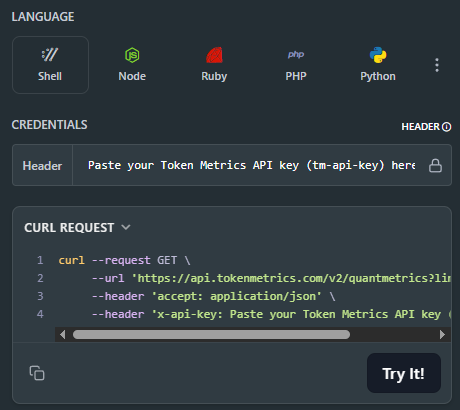
👉 Keep momentum: Get API Key • Run Hello-TM • Clone a Template
Kick off from quickstarts in the docs—fork a dashboard or screener template, plug your key, and deploy in minutes. Validate your environment with Run Hello-TM; when you need more throughput or webhooks, compare API plans.
Quantmetrics computes risk-adjusted performance over a chosen lookback (e.g., 30d, 90d, 1y). You’ll receive a JSON snapshot with core statistics:
Call /v2/quantmetrics?symbol=<ASSET>&window=<LOOKBACK> to fetch the current snapshot. For dashboards spanning many tokens, batch symbols and apply short-TTL caching. If you generate alerts (e.g., “Sharpe crossed 1.5”), run a scheduled job and queue notifications to avoid bursty polling.
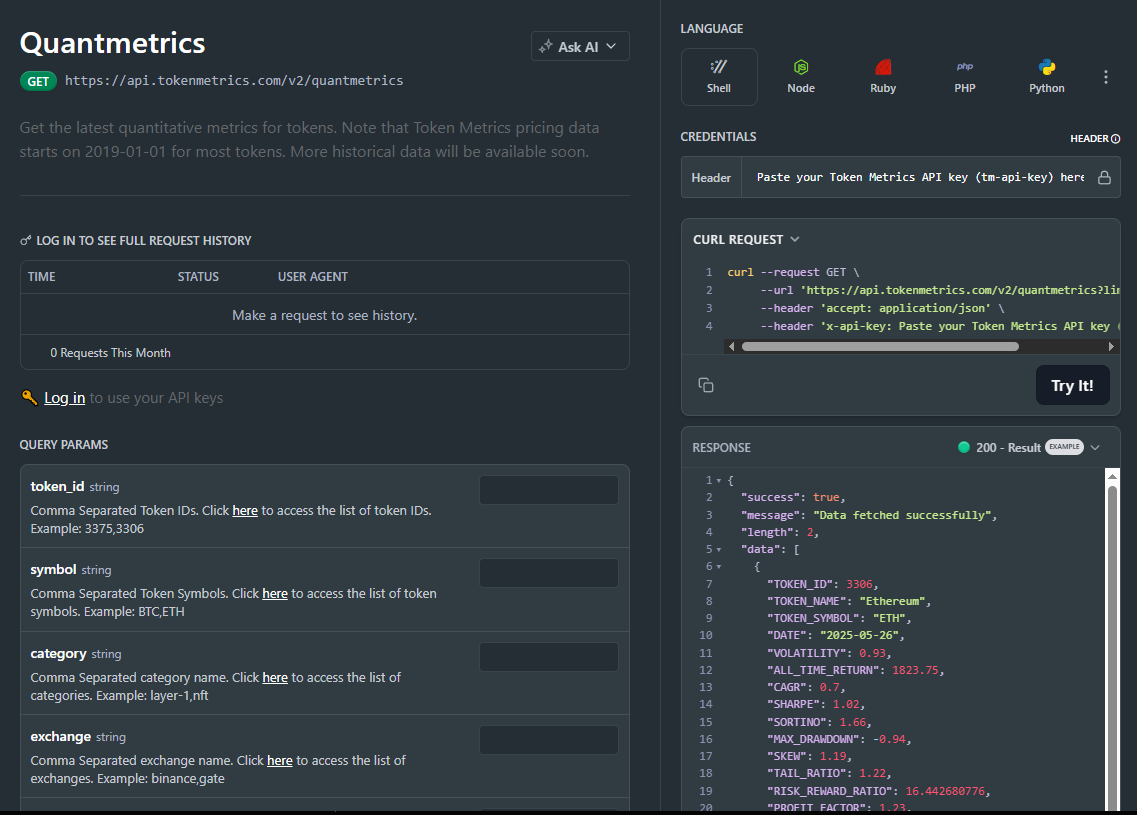
1) What does the Quantmetrics API return?
A JSON snapshot of risk-adjusted metrics (e.g., Sharpe, Sortino, volatility, max drawdown, CAGR) for a symbol and lookback window—ideal for ranking, sizing, and dashboards.
2) How fresh are the stats? What about latency/SLOs?
Responses are engineered for predictable latency. For heavy UI usage, add short-TTL caching and batch requests; for alerts, use scheduled jobs or webhooks where available.
3) Can I use Quantmetrics to size positions in a live bot?
Yes—many quants size inversely to volatility or require Sharpe ≥ X to trade. Always backtest and paper-trade before going live; past results are illustrative, not guarantees.
4) Which lookback window should I choose?
Short windows (30–90d) adapt faster but are noisier; longer windows (6–12m) are steadier but slower to react. Offer users a toggle and cache each window.
5) Do you provide SDKs or examples?
REST is straightforward (JS/Python above). Docs include quickstarts, Postman collections, and templates—start with Run Hello-TM.
6) Polling vs webhooks for quant alerts?
Dashboards usually use cached polling. For threshold alerts (e.g., Sharpe crosses 1.0), run scheduled jobs and queue notifications to keep usage smooth and idempotent.
7) Pricing, limits, and enterprise SLAs?
Begin free and scale up. See API plans for rate limits and enterprise SLA options.

%201.svg)
%201.svg)
The cryptocurrency industry is witnessing a paradigm shift as major exchanges race to build comprehensive "super apps" that consolidate trading, social features, and DeFi into single platforms. Leading this revolution is Coinbase's Base app, a ambitious project that could redefine how users interact with crypto.
The Base app represents Coinbase's vision of a crypto "everything app" – think WeChat for the blockchain era. Built on Coinbase's Layer 2 solution, Base, this platform integrates multiple crypto functions into one seamless experience:
1. Centralized & Decentralized Trading
2. Social Creator Economy
3. Mini App Ecosystem
4. Integrated Payments
Farcaster serves as the technical backbone for the Base app's social and mini-app functionality. As a decentralized social networking protocol built on Ethereum, Farcaster enables:
The Base app ecosystem presents significant opportunities for developers:
Mini App Development:
Success Stories:
Multiple major exchanges are pursuing similar strategies:
Coinbase (Base):
OKX (X Layer):
Binance (BNB Chain):
Kraken (Inc L2):
The exchange blokchain trend is driving significant value creation:
BNB Example:
Implications for Coinbase:
1. Regulatory Clarity
2. User Experience Focus
3. Ecosystem Integration
4. Developer Support
The Base app is designed to create powerful network effects:
Aerodrome (AERO):
Farcaster Ecosystem:
Zora (ZORA):
Base Ecosystem Tokens:
Scalability Concerns:
Competition Intensity:
Token Launch Uncertainty:
International Expansion:
Narrative Rotation:
The success of super apps could fundamentally change crypto:
User Behavior:
Developer Economics:
Market Structure:
Crypto super apps pose a direct threat to:
Current Status: Limited beta with waitlist Access Methods:
Preparation Steps:
Opportunity Windows:
The Base app represents more than just another crypto platform – it's a bet on the future of digital interaction. Success could establish Coinbase as the dominant force in crypto user experience, while failure could cede ground to more agile competitors.
User Adoption:
Developer Ecosystem:
Market Performance:
The Coinbase Base app represents a potentially transformative moment in crypto infrastructure. By combining social features, trading capabilities, and developer tools into a single platform, it could become the primary gateway for mainstream crypto adoption.
For investors and developers, the opportunity lies not just in the Base app itself, but in the entire ecosystem it's creating. Early positioning in Base-native projects, particularly those with lower market caps and strong integration potential, could yield significant returns as the platform scales.
However, success is far from guaranteed. The competitive landscape is intense, regulatory challenges remain, and crypto market narratives shift rapidly. The winners will be those who can execute flawlessly while adapting to changing market conditions.
The race for the crypto super app is just beginning – and the Base app has taken an early lead.
Stay ahead of crypto infrastructure trends. The platforms that win user mindshare today will shape the industry's future tomorrow.
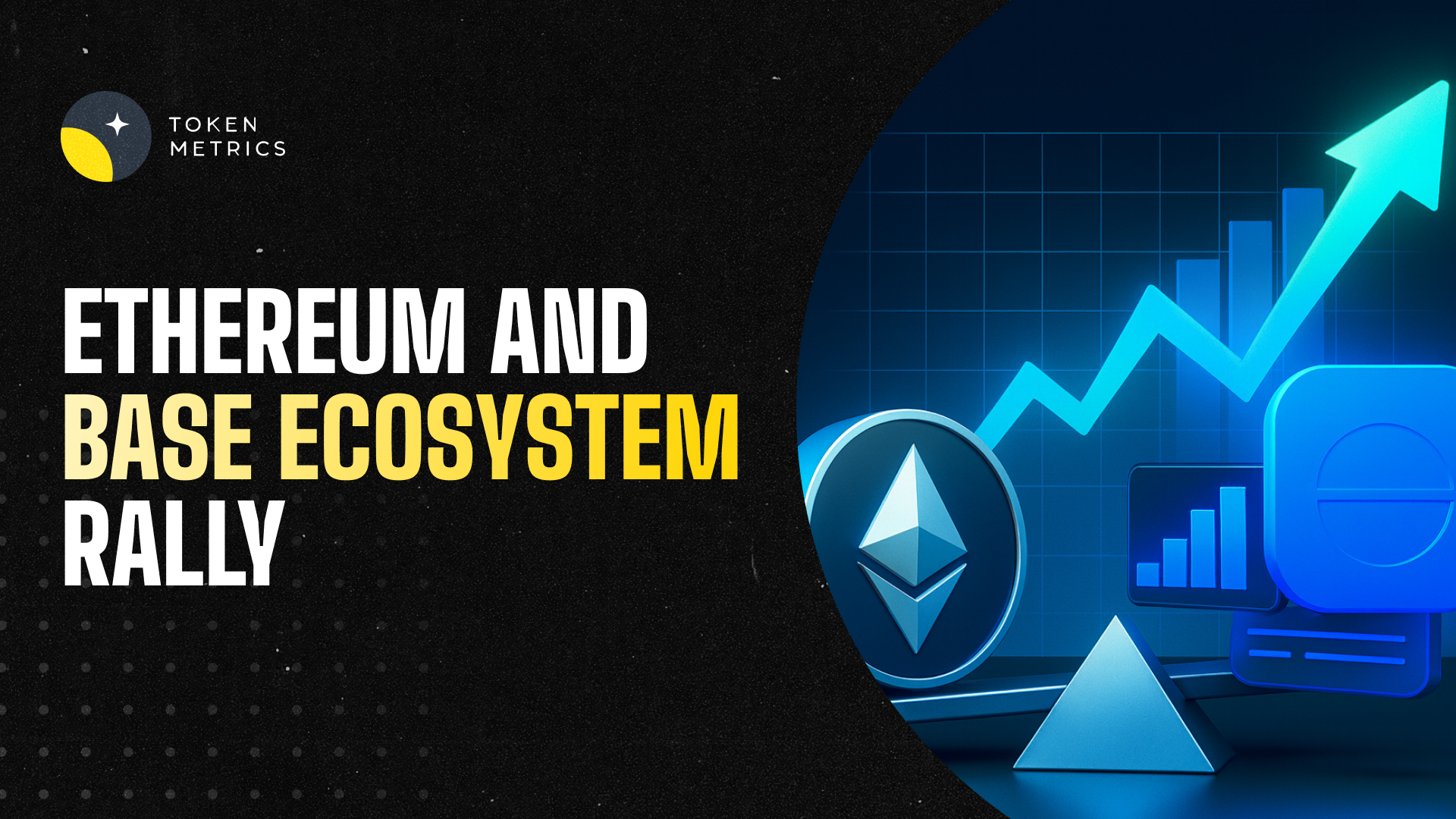
%201.svg)
%201.svg)
The cryptocurrency market is experiencing a significant narrative shift, with Ethereum and Base ecosystem projects leading the charge in early 2025. Recent market analysis reveals a concentrated rally in ETH-related tokens, presenting both opportunities and risks for crypto traders.
The crypto market has entered what experts are calling "Ethereum season," with ETH positioning itself as the number two highest-rated token in terms of trader grade. This surge isn't coincidental – it's driven by several key factors:
Major corporations are increasingly adding Ethereum to their treasury holdings, following the path Bitcoin paved. This institutional adoption has created sustained buying pressure, with Ethereum benefiting from the same "digital gold" narrative that propelled Bitcoin to new heights.
Coinbase's Layer 2 solution, Base, has become the most relevant L2 network, overtaking Arbitrum's previous dominance. The recent rebranding of Coinbase Wallet to the "Base app" has created a powerful ecosystem effect, benefiting projects deeply integrated with Base infrastructure.
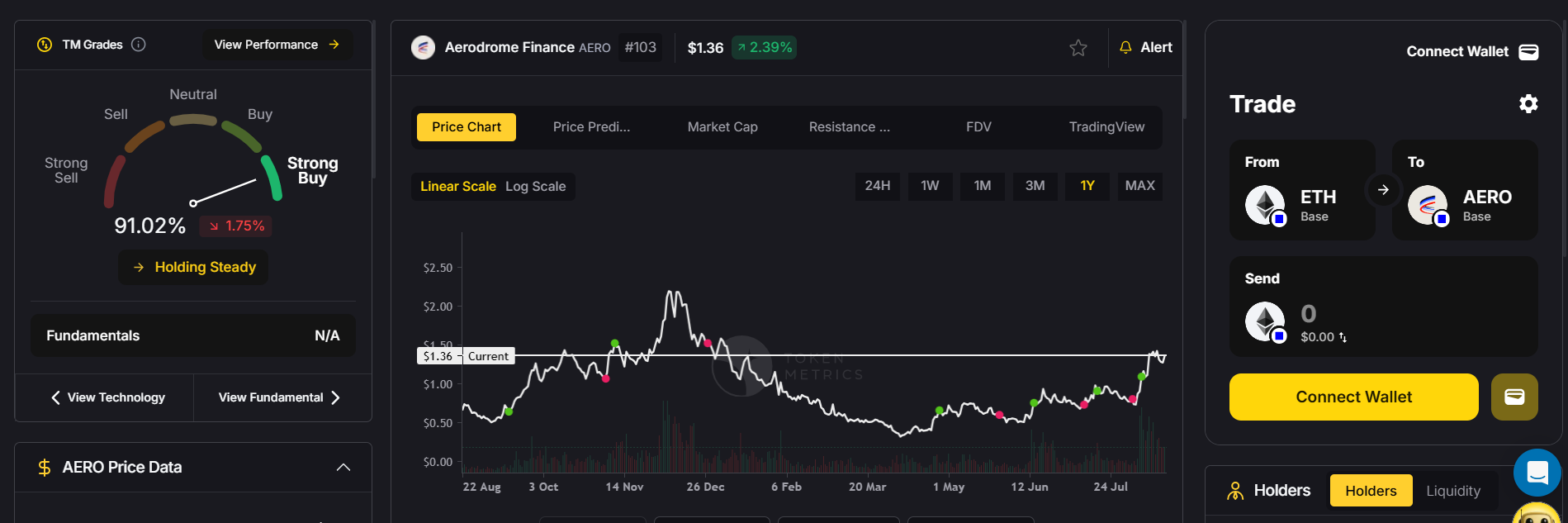
Current Market Cap: $1.2 billion
FDV: $2.3 billion
Aerodrome has emerged as the go-to liquidity solution for the Base ecosystem. With its tight integration into Coinbase's Base app ecosystem, AERO has significant upside potential as the Base app remains in limited beta. Once full access opens to Coinbase's broader user base, liquidity demand could skyrocket.
Key Advantages:

Current Market Cap: Under $1 billion
FDV: $1.6 billion
Pendle is positioning itself as essential DeFi infrastructure, often compared to the "new Aave." The project has attracted significant institutional investment and offers unique yield trading mechanisms that differentiate it from traditional lending protocols.
Growth Drivers:

Current Market Cap: $2.3 billion
FDV: $11.6 billion
Ethena has created a revolutionary synthetic stablecoin (USDe) that generates yield through delta-neutral trading strategies. The protocol has achieved remarkable growth, reaching 10 billion in stablecoin supply faster than both USDC and Tether historically.
Unique Features:
The current market requires a narrative-focused trading strategy rather than pure fundamental analysis. Here's why:
The crypto market has become increasingly trader-oriented, with attention shifting between sectors rapidly. Projects with strong fundamentals can underperform if they're not part of the current narrative cycle.
Previous cycles show clear rotation patterns:
Smart traders are:
Coinbase's strategic moves are creating a "super app" ecosystem similar to WeChat but built on crypto rails:
Other exchanges are following suit:
History shows that even blue-chip projects can decline 85-90% when narratives shift. AI tokens like AXBT fell from $0.80 to $0.13 despite strong fundamentals.
The Ethereum/Base narrative may be reaching maturity. Smart money is:
Successful traders are implementing:
Smart traders are already positioning for potential rotations into:
The Ethereum and Base ecosystem rally presents compelling short-term opportunities, but requires disciplined execution and risk management. Focus on projects with strong narrative alignment, lower valuations relative to peers, and clear catalysts for continued growth.
Remember: in the current market environment, being right about fundamentals isn't enough – you need to be right about narrative timing. Stay flexible, use alerts effectively, and be prepared to rotate when the market's attention shifts.
The crypto market moves fast. Stay informed with real-time analysis and trading signals to maximize your opportunities while managing risk effectively.

%201.svg)
%201.svg)
As crypto trading automation accelerates into 2025, choosing the right API interface for your bot could be the critical difference between lagging behind or capitalizing on real-time opportunities. But when it comes to REST vs WebSocket crypto APIs, which technology should you select for power, reliability, and performance? This post details the core differences, essential trade-offs, and latest best practices for crypto API comparison, empowering you to make a technical, mission-aligned decision for your next-generation trading bot.
To understand which API protocol is optimal for your crypto bot in 2025, let’s clarify what REST and WebSocket actually do—especially in a high-frequency, automation-driven ecosystem.
The fundamental contrast: REST works in a "pull" model (request/response), while WebSockets operate in a "push" paradigm (real-time streams). This distinction plays a major role in how bots interact with exchanges and handle crypto market shifts.
Performance and data freshness are critical for crypto APIs in 2025. High-frequency or latency-sensitive trading bots depend on receiving accurate, instant data on price movements and order book changes.
Yet reliability considerations persist. WebSocket connections may experience drops, require reconnection logic, and occasionally miss events during high network volatility. REST, while slower, may provide more consistency under unstable conditions.
Your crypto bot’s requirements—frequency of updates, types of orders, and compliance frameworks—may drive the API choice. Here’s how REST and WebSocket compare across scenarios relevant in 2025:
Security-wise, REST can offer granular access controls per endpoint. WebSockets, though encrypted, have unique session management and timeout considerations—especially important for bots managing real funds.
In the ever-evolving crypto automation landscape, developers and researchers are seeing:
Ultimately, the “better” API depends on your bot’s profile: Speed-critical, event-driven bots gravitate to WebSockets, while research bots or those trading on daily signals may remain with REST. Many leading bot frameworks in 2025 offer seamless switching or even run hybrid workflows for best-in-class resilience.
When evaluating crypto APIs for your bot or automation project, consider these practical criteria:
Above all, test API performance in real-market scenarios—using sandboxes or historical replays—to ensure your bot’s architecture is future-proofed for 2025 volatility and growth.
Build Smarter Crypto Apps & AI Agents with Token Metrics
Token Metrics provides real-time prices, trading signals, and on-chain insights all from one powerful API. Grab a Free API Key
REST APIs use isolated request/response cycles and are suited for infrequent or simple queries. WebSocket APIs sustain continuous, two-way connections for real-time market data updates. The choice depends on whether your bot needs static or streaming data.
WebSocket APIs are preferred for real-time trading bots due to their lower latency and ability to push instant data updates. However, implementation complexity and stability must be considered.
Yes. Many bots use REST for account management or trade execution and WebSocket for live data streams. This hybrid approach leverages the strengths of each protocol.
Both protocols utilize SSL encryption and API key-based authentication, but WebSocket sessions require more careful management and regular re-authentication to prevent stale or hijacked connections.
Assess your bot’s use case—speed versus reliability, frequency of queries, data intensity, and integration requirements. Testing both protocols with your trading logic is recommended for optimization.
This content is for educational and informational purposes only. It does not constitute investment, trading, or financial advice. Past performance and API platform capabilities are not guarantees of future results. Always perform independent research and technical due diligence before building or deploying trading bots or utilizing API-based automation tools.

%201.svg)
%201.svg)
Coding your first crypto trading bot can be an exciting journey into algorithmic trading, automation, and the world of digital assets. But for many beginners, the path is full of unexpected hurdles. Rushing into bot development without understanding key risks can lead to costly errors, technical failures, and frustration. In this article, we break down the top mistakes to avoid when building your first crypto trading bot, and offer actionable insights so you can start your automation journey on solid ground.
Many new developers are eager to start building a crypto trading bot after seeing success stories or reading about impressive returns from algorithmic strategies. However, skipping foundational learning can result in critical errors:
Before you start coding, invest time to learn how exchanges work, typical trading strategies, and the programming language you intend to use (often Python or JavaScript for most bot frameworks). Familiarize yourself with basic quantitative analysis and backtesting tools to ground your bot in solid logic.
One of the most widespread beginner crypto bot mistakes is failing to build robust risk controls into the automated system. While automation can remove human error and emotion, it cannot protect you from strategy-flaws or market anomalies by default. Major risks include:
Consider embedding risk-limiting features. For example, restrict order sizes to a fraction of your total balance and always code for the possibility of missed, delayed, or partially filled orders.
APIs are the backbone of any crypto trading bot, allowing programmatic access to price data, balances, and order actions. For beginners, choosing subpar or poorly documented APIs is a frequent pitfall. Key issues include:
Take time to evaluate API documentation, community support, and reliability. Explore well-maintained libraries and modules, and always use environment variables or secure vaults for your credentials.
It's tempting to deploy your trading bot live the moment it compiles without error. However, skipping backtesting—testing your bot on historical data—or forward-testing on a demo account is a recipe for unexpected behavior. Top mistakes here include:
Carefully test your strategies with a range of market conditions and environments before risking live funds. Look for open-source backtesting libraries and consider using paper trading features offered by many exchanges.
Crypto trading bots operate with sensitive account access and sometimes large balances at risk. New developers often underestimate the importance of security and regulatory compliance. Watch out for:
Implement best practices for code security and stay attentive to legal developments in your jurisdiction. Avoid shortcuts that could put your assets or reputation in danger.
Build Smarter Crypto Apps & AI Agents with Token Metrics
Token Metrics provides real-time prices, trading signals, and on-chain insights all from one powerful API. Grab a Free API Key
Most crypto trading bots are built in Python or JavaScript due to strong libraries and exchange support. Some advanced users deploy bots in Java, C#, or Go for higher performance, but Python is considered beginner-friendly.
Start with backtesting using historical data, then use exchange-provided sandboxes or paper trading environments. This lets you observe your bot’s actual behavior without risking real money or assets.
Store API keys in environment variables or encrypted vaults, restrict key permissions, and never share or publish them. Rotate keys periodically and monitor logs for unauthorized activity.
Yes; even well-tested bots can lose money due to market changes, exchange outages, slippage, or unforeseen bugs. Continuous monitoring and updates are essential for risk control.
Platforms offering real-time market data, robust APIs, and community support can help. AI-powered research tools like Token Metrics can assist with backtesting and market analysis, while open-source frameworks provide learning resources.
This article is for educational purposes only and should not be construed as investment, financial, or trading advice. Crypto trading bots carry risks, and readers should conduct thorough research and consult with professionals as appropriate. Always follow relevant laws and exchange terms of service.

%201.svg)
%201.svg)
Automating crypto trading with APIs is revolutionizing how traders and developers interact with digital asset markets. If you've ever wondered how to connect directly to exchanges like Binance and Coinbase, automate your strategies, or build your own trading bots, understanding their APIs is the crucial first step. This guide unpacks the essentials of using the Binance and Coinbase APIs for automated crypto trading—explaining the technology, potential use cases, and important considerations for getting started.
APIs, or Application Programming Interfaces, enable software to interact directly with external services. Within cryptocurrency trading, APIs provide a standardized way for users and programs to connect with exchange platforms, fetch market data, execute trades, manage portfolios, and access account information programmatically.
This seamless integration supports the development of sophisticated trading strategies, algorithmic trading bots, portfolio trackers, and research analytics. The most widely adopted crypto trading APIs are those offered by Binance and Coinbase, two of the largest global exchanges.
Binance’s API is well-documented, robust, and supports diverse endpoints for both spot and futures markets.
Popular use cases for Binance API trading include automated execution of trading signals, quantitative strategy deployment, and real-time portfolio rebalancing. The official documentation is the go-to resource for development references. Consider open-source SDKs for Python, Node.js, and other languages to streamline integration.
Coinbase provides comprehensive APIs for both its retail platform and Coinbase Advanced Trade (previously Coinbase Pro). These APIs are favored for their security and straightforward integration, especially in regulated environments.
Use the Coinbase API for automated dollar-cost averaging strategies, portfolio analytics, or to connect external research and trading tools to your account. Always apply IP whitelisting and two-factor authentication for heightened security.
While APIs empower sophisticated trading automation, several technical and strategic considerations should be addressed:
For more complex strategies, combining data from multiple APIs—including on-chain analytics and AI-powered research—can provide deeper insights and help navigate uncertain market conditions.
The real advantage of programmatic trading emerges when combining API connectivity with AI-driven analytics. Developers can harness APIs to fetch live data and feed it into machine learning models for signal generation, anomaly detection, or portfolio optimization. Tools like Python’s scikit-learn or TensorFlow—paired with real-time data from Binance, Coinbase, and third-party sources—enable dynamic strategy adjustments based on shifting market trends.
AI agents and intelligent trading bots are increasingly built to interface directly with crypto APIs, processing complex data streams to execute trades or manage risk autonomously. Such systems benefit from robust backtesting, frequent monitoring, and a modular design to ensure security and compliance with exchange requirements.
Build Smarter Crypto Apps & AI Agents with Token Metrics
Token Metrics provides real-time prices, trading signals, and on-chain insights all from one powerful API. Grab a Free API Key
Both Binance and Coinbase offer REST APIs, but Binance has broader asset coverage and advanced trading features, including futures and options support. Coinbase’s APIs prioritize security, are well-suited for U.S. users, and offer streamlined integration for both spot and advanced trade scenarios.
Python, JavaScript/Node.js, and Java are the most popular choices for building automated trading bots due to the availability of SDKs and community support. Most modern APIs are RESTful and compatible with any language that can perform HTTP requests.
Best practices include storing API keys in environment variables, never exposing them in source code repositories, limiting permissions, and regularly rotating keys. Also, use IP whitelisting and two-factor authentication if supported by the exchange.
Yes. Many advanced traders aggregate data and trade across several exchange APIs to increase liquidity access, compare prices, or diversify strategies. This often requires unifying different API schemas and handling each exchange’s unique rate limits and authentication protocols.
Automated trading can lead to unintended losses if there are bugs in the code, API changes, or sudden market movements. Proper error handling, backtesting, and initial development in sandbox/testnet environments are key risk mitigation steps.
This article is for informational and educational purposes only. It does not constitute investment advice or an offer to buy or sell any cryptocurrency. Always implement robust security practices and perform due diligence before integrating or deploying automated trading solutions.

%201.svg)
%201.svg)
Crypto trading bots have transformed how traders and analysts approach the fast-moving digital assets market. With a variety of automated strategies—like Dollar Cost Averaging (DCA), grid trading, and arbitrage—these bots help users implement consistent, rules-based tactics around the clock. But understanding how each strategy works, their strengths and limitations, and the technology that powers them is crucial for anyone looking to utilize automation in crypto trading.
Crypto trading bots are software programs designed to automate trading decisions based on predefined criteria and algorithms. These tools connect to crypto exchanges via API, executing trades according to parameters set by the user or the strategy's logic. The goal isn’t to guarantee profit, but to implement systematic, emotion-free trading practices at speed and scale impossible for humans alone.
Common features among top crypto trading bots include:
With AI and advanced analytics, bots now utilize sophisticated signals—from price action to on-chain data—to further enhance decision-making.
Dollar Cost Averaging (DCA) is a foundational investing concept, and DCA bots automate its application in the crypto markets. The DCA strategy involves purchasing a set amount of cryptocurrency at regular intervals, irrespective of price fluctuations. This method reduces exposure to volatility and removes the need to time market tops or bottoms.
A DCA bot performs these actions by connecting to your chosen crypto exchange and placing periodic orders automatically. Customizable options include:
Scenario analysis: For long-term market participants, DCA bots can smooth out entry prices during periods of high volatility, especially in trending or sideways markets. However, DCA does not prevent losses in downtrending markets and might not be optimal for short-term speculation.
Many platforms offer DCA bots, and some combine DCA with AI-driven market indicators, offering more nuanced deployment. Tools like Token Metrics provide research that can help users evaluate when and how to use DCA strategies alongside their risk management framework.
Grid trading bots are designed to profit from price oscillations within a defined range by placing a series of buy and sell orders at predetermined intervals (the "grid"). As the market moves, the bot buys low and sells high within this corridor, striving to capture profits from repeated fluctuations.
Key components of a grid trading bot:
Grid trading is best suited for markets with horizontal price movement or mild volatility. It may underperform during strong trends (up or down) as the price moves outside the set grid.
To optimize grid performance, traders often analyze historical price ranges, volatility indices, and liquidity metrics—processes where AI tools and platforms like Token Metrics can provide data-driven insights to fine-tune grid parameters.
Arbitrage is the practice of exploiting price differences of the same asset across different exchanges or markets. Arbitrage bots automate the process, rapidly identifying and capitalizing on even small price discrepancies before the market corrects itself.
There are several types of crypto arbitrage:
Arbitrage bots require:
While arbitrage opportunities exist in crypto due to market fragmentation and varying liquidity, increased competition and improved exchange efficiency have narrowed average profit margins. Bots are now often paired with on-chain analytics or machine learning models to anticipate emerging inefficiencies.
Not all strategies suit all market conditions. Choosing and optimizing a crypto trading bot strategy involves:
Advanced users often create hybrid strategies—such as combining DCA for accumulation with a grid bot for ranging periods, or adding arbitrage layers where price disparities appear. AI-based research solutions can help proactively monitor correlations, identify volatility shifts, and surface emerging patterns, providing analytical depth to trading bot strategy selection.
Before using any trading bot or automated strategy, it is essential to understand the underlying logic, risk controls, and limitations. Start with small amounts, test thoroughly, and review available documentation and analytics from trusted platforms.
Enhance Your Trading with Token Metrics
Token Metrics offers real-time prices, trading signals, and on-chain insights to help you make informed decisions. Start Trading Smarter Today
Most crypto trading bots can support major coins (Bitcoin, Ethereum) and numerous altcoins, depending on the exchanges and APIs integrated. Liquidity and exchange pairs may limit available strategies for smaller tokens.
Bots use APIs provided by exchanges to access trading accounts and execute orders automatically. API permissions usually allow for account security by limiting withdrawal capabilities to prevent misuse.
No single strategy is universally better; each suits different market conditions and goals. DCA aims to reduce volatility impact, grid bots thrive in ranging markets, and arbitrage bots seek price discrepancies across platforms.
AI can enhance trading bots by analyzing large datasets, identifying patterns, and generating trading signals based on market sentiment, technical factors, or on-chain activity. Platforms like Token Metrics integrate AI-driven analytics for more informed strategy design and monitoring.
Risks include technological errors, unexpected market volatility, slippage, API downtime, and exchange limitations. It is important to monitor bot activity, use strong security practices, and test any automated strategy before deploying significant capital.
This blog post is for informational and educational purposes only. It does not constitute investment advice, financial guidance, or a recommendation to buy or sell any asset. All strategies discussed involve risks, and past performance is not indicative of future results. Readers should conduct independent research and consult with a qualified professional before using crypto trading bots or related technologies.

%201.svg)
%201.svg)
The surge in automated crypto trading has fueled demand for robust backtesting solutions. Whether you're a developer refining an algorithm or a trader validating a new crypto trading bot strategy, reliable backtesting tools are essential. As we head into 2025, new platforms, APIs, and open-source scripts are making it easier than ever to simulate strategies before risking capital in live markets.
Backtesting allows you to simulate a trading strategy using historical market data to understand its hypothetical performance. Effective backtesting can help developers, quant traders, and crypto enthusiasts:
In fast-moving crypto markets, proper backtesting helps remove emotional bias and provides a data-driven framework for decision-making. This process is especially valuable for those employing systematic or algorithmic crypto trading bot strategies.
Choosing the right backtesting platform depends on your technical expertise, data requirements, and desired features. Here are some of the top solutions as of 2025:
When evaluating platforms, consider factors like data granularity, exchange integrations, speed, and the transparency of performance metrics.
APIs allow automated strategies to fetch accurate historical data, process live prices, and execute simulated orders. Here’s what to look for in a top-tier backtesting API in 2025:
Some of the leading APIs in 2025 for crypto bot backtesting include CoinGecko, CryptoCompare, Kaiko, and the Token Metrics API, which combines deep on-chain analysis with predictive trading signals and streamlined integration for quant developers.
Build Smarter Crypto Apps & AI Agents with Token Metrics
Token Metrics provides real-time prices, trading signals, and on-chain insights all from one powerful API. Grab a Free API Key
For those who want full control or need to extend capabilities beyond platform GUIs, open-source scripts and frameworks give maximum flexibility for research and development. Some of the noteworthy options in the crypto bot backtesting landscape include:
When selecting or building custom scripts, prioritize transparency in calculations, accuracy in data handling, and the ability to reproduce results. Open-source frameworks are ideal for researchers who want to customize every aspect of their crypto trading bot strategy testing.
The integration of AI into backtesting is rapidly changing how traders and quant researchers optimize their strategies. In 2025, many leading platforms and APIs incorporate:
AI-driven backtesting tools enable users to uncover hidden patterns and quantify risks faster than ever. Solutions like Token Metrics are leading this wave by combining traditional backtesting tools with advanced, AI-powered analytics, helping crypto developers and researchers navigate the increasing complexity of digital asset markets.
Crypto bot backtesting is the process of simulating a trading strategy on historical cryptocurrency price and volume data. It helps developers and researchers assess how a strategy would have performed, identify risk factors, and optimize settings—before using the strategy with real funds.
Backtesting accuracy depends on factors such as data quality, inclusion of transaction costs, realistic slippage modeling, and whether the logic matches live market execution. While valuable, backtest results should be interpreted with caution and validated with out-of-sample data or paper trading.
Python is the most widely used language for crypto bot backtesting due to its rich ecosystem (Backtrader, Freqtrade, Pandas). Other popular options include JavaScript (Node.js for integrations), and C# (.NET-based research or GUIs).
Yes, AI enhances backtesting by helping discover market patterns, optimize trading rules, and incorporate additional data sources such as on-chain analytics or social sentiment. Advanced platforms leverage AI to power predictive analytics and scenario modeling.
Consider your technical proficiency, need for custom logic, required data granularity, exchange and API integrations, performance analytics, and whether you prefer GUI-based platforms or scriptable frameworks. Test your strategy on several tools for benchmarking.
This article is for educational and informational purposes only. It does not offer investment, financial, or trading advice. Use all tools and scripts at your own risk, and conduct thorough due diligence before deploying live trading strategies.

%201.svg)
%201.svg)
Automated trading is transforming the crypto landscape—expediting strategies and reducing manual intervention. Whether you're a developer, researcher, or an enthusiastic learner, free crypto trading bot templates offer a hands-on way to explore algorithmic trading without steep costs. Thanks to generous contributors on GitHub, a wealth of open-source crypto bot projects are available for anyone looking to accelerate their learning and experiment with automation.
The allure of algorithmic trading isn't just reserved for hedge funds or large trading desks. With the rise of free crypto trading bot templates, a broad audience can now experiment with market analysis, automation, and even basic forms of AI-driven strategies. Crypto bot GitHub repositories range from simple starter scripts to sophisticated frameworks capable of complex quantitative analysis. For crypto enthusiasts, these bots serve as valuable tools to:
However, it’s essential to remember that most open-source bots, while educational, are not plug-and-play solutions for live, unsupervised trading. Their main value lies in experimentation, research, and skills development rather than profit guarantees.
Numerous GitHub repositories have become go-to resources for those seeking free crypto trading bot solutions. Here are some of the most notable options for developers of all skill levels:
Always review each project’s documentation and security model before deploying or connecting to live funds.
Most open-source crypto trading bot templates follow a similar architecture:
More advanced templates even support plug-and-play AI or ML modules, leveraging frameworks like TensorFlow or PyTorch for data-driven strategy testing. However, for most beginners, starting with backtesting and moving to live simulation using paper trading is a safer path.
Jumping into crypto bot development is surprisingly accessible—even for those without a formal developer background. Here are the basic steps for getting started:
Community forums and project Discords can also provide invaluable troubleshooting support.
Because free crypto trading bots require exchange API keys, it’s critical to understand best practices and inherent risks:
These practices safeguard both your assets and your personal data while experimenting with crypto trading automation.
Enhance Your Trading with Token Metrics
Token Metrics offers real-time prices, trading signals, and on-chain insights to help you make informed decisions. Start Trading Smarter Today
Safety depends on the code quality, maintenance, and how you handle API keys. Always test with paper trading, use limited API permissions, and review the codebase for security issues before any real usage.
Basic familiarity with programming and your chosen language (often Python or JavaScript) is very helpful. Some projects offer easy-to-use config files, but customizing strategies usually requires code changes.
Popular open-source bots often support major exchanges like Binance, Coinbase Pro, KuCoin, and Kraken via libraries like CCXT. Always check each bot’s documentation for up-to-date exchange compatibility.
Many free crypto trading bots allow live trading, but it's strongly recommended to start with paper trading mode and proceed cautiously. Ensure security measures are implemented, and always monitor live bots actively.
Token Metrics provides AI-powered ratings, on-chain analytics, and backtesting tools that can help you evaluate and refine your algorithmic trading ideas across different crypto assets.
This content is for educational and informational purposes only. It does not constitute investment advice, financial recommendations, or endorsements of any project or protocol. Always exercise caution and conduct your own research when using open-source trading bots or engaging in automated crypto trading.

%201.svg)
%201.svg)
Building or upgrading a crypto platform in 2025 demands reliable, fast, and versatile APIs. Whether you’re developing a trading algorithm, a portfolio tracker, or a wallet application, integrating the right crypto APIs can be the linchpin of user experience and product success. With blockchain and digital assets maturing rapidly, today’s APIs deliver not only real-time price data, but also advanced trading features and seamless wallet integration. But which APIs stand out from the pack?
API solutions have evolved into indispensable tools for developers, quantitative analysts, businesses, and anyone seeking reliable crypto integration. Here are 10 standout crypto APIs for 2025, each offering a unique mix of performance, breadth, and versatility:
The “best” crypto API for 2025 depends on whether your priority is trading, data analytics, wallet management, or web3 protocol interaction. Many forward-thinking teams are now combining several APIs to achieve flexible, scalable architecture.
With so many options, careful API evaluation is crucial. Consider the following practical factors before integrating a new crypto API:
Test multiple APIs in sandbox environments to validate uptime, accuracy, and compatibility with your backend infrastructure or front-end frameworks.
Strategic API integration expands what’s possible for developers and crypto businesses. Consider three core implementation scenarios for 2025:
For teams scaling across blockchains or global jurisdictions, modular design using the leading crypto APIs ensures adaptability and resilience as the ecosystem evolves in 2025 and beyond.
The crypto API landscape is moving fast with several trends shaping developer choices and user expectations:
Whether you’re prototyping a new app or enhancing a mature platform, staying up-to-date with these innovations ensures your tech stack remains competitive and agile as the regulatory and market landscape shifts.
Build Smarter Crypto Apps & AI Agents with Token Metrics
Token Metrics provides real-time prices, trading signals, and on-chain insights all from one powerful API. Grab a Free API Key
Accuracy can depend on exchange coverage and update frequency. APIs like CoinGecko, CoinMarketCap, and Token Metrics aggregate data from multiple sources to improve reliability. Always test feeds for your specific asset list.
A crypto wallet API enables developers to add wallet functionalities—such as creating, managing, and sending cryptocurrencies—directly within apps. Leading options like Alchemy and Fireblocks allow seamless blockchain transactions and secure asset management.
Yes. Many top crypto APIs, such as CoinGecko, Moralis, and Token Metrics API, offer free tiers for development and low-usage applications. However, higher volume or advanced features may require paid plans.
Prioritize APIs with robust authentication, encryption, and documented security protocols. Use API keys or OAuth, monitor for suspicious activity, and regularly audit your application’s handling of user data and crypto operations.
Yes. Advanced APIs such as Token Metrics provide AI-driven analytics, signals, and predictive tools to enhance research and strategy development. These can be integrated into custom dashboards or apps for additional intelligence.
This article is for informational and educational purposes only. It does not constitute financial, legal, or investment advice. Please conduct your own research and consult licensed professionals before making technical or business decisions involving cryptocurrency technology or markets.


 Create Your Free Account
Create Your Free Account9450 SW Gemini Dr
PMB 59348
Beaverton, Oregon 97008-7105 US
.svg)




.png)
Token Metrics Media LLC is a regular publication of information, analysis, and commentary focused especially on blockchain technology and business, cryptocurrency, blockchain-based tokens, market trends, and trading strategies.
Token Metrics Media LLC does not provide individually tailored investment advice and does not take a subscriber’s or anyone’s personal circumstances into consideration when discussing investments; nor is Token Metrics Advisers LLC registered as an investment adviser or broker-dealer in any jurisdiction.
Information contained herein is not an offer or solicitation to buy, hold, or sell any security. The Token Metrics team has advised and invested in many blockchain companies. A complete list of their advisory roles and current holdings can be viewed here: https://tokenmetrics.com/disclosures.html/
Token Metrics Media LLC relies on information from various sources believed to be reliable, including clients and third parties, but cannot guarantee the accuracy and completeness of that information. Additionally, Token Metrics Media LLC does not provide tax advice, and investors are encouraged to consult with their personal tax advisors.
All investing involves risk, including the possible loss of money you invest, and past performance does not guarantee future performance. Ratings and price predictions are provided for informational and illustrative purposes, and may not reflect actual future performance.

